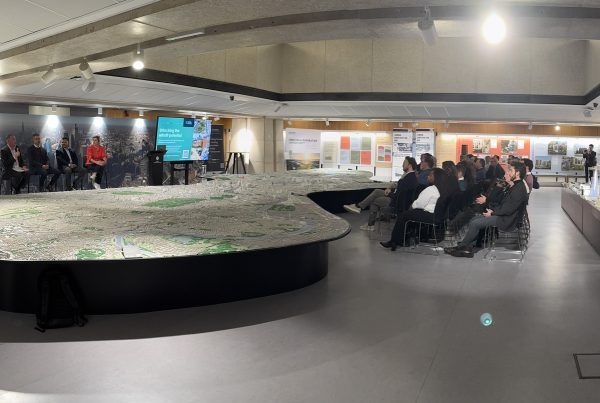
Within the construction industry, sustainability has a wide range of benefits but one of the biggest and most important advantages is its environmental impact. Sustainable construction reduces environmental harm, helping mitigate climate change and its impacts. There are many ways in which the industry can operate in a way that promotes environmental sustainability in construction. With the environment as the primary goal for sustainability, the construction industry also receives secondary benefits that are a great bonus.
What is Environmental Sustainable Construction?
Environmental sustainability in construction involves designing, building, operating, and maintaining buildings in ways that minimise environmental impact, conserve resources, and support the long-term health of ecosystems and communities. The way construction companies function from the ground up involves the eco-friendly operation of businesses and their corresponding sites with a focus on energy efficiency and waste reduction while utilising recycled materials. This supports the environment by preserving scarce resources, reducing carbon emissions and limiting waste, protecting the local environment and helping to support global efforts to tackle climate issues.
Sustainable Construction Materials
One of the biggest ways that sustainable construction can support environmental goals is through the use of sustainable materials. There are many ways that construction sites can incorporate recycled materials into their developments, including the use of recycled steel, recycled glass and reclaimed wood. Construction companies can also take advantage of readily available natural resources, such as wool, which can be used as insulation. Hempcrete is a low-carbon, durable material that absorbs CO₂ during curing, reducing its overall environmental impact. By using these sustainable materials, scarce natural resources are preserved, carbon footprints are reduced, and less waste is produced by the construction industry.
Energy Efficiency
Construction companies can practice energy efficiency from the very beginning and throughout the entire construction process. It is common for modern offices to now have methods in place to reduce energy consumption, and some of these practices are being rolled out into construction sites. Construction sites are increasingly incorporating renewable energy sources like solar panels and improving efficiency through insulation and other energy-saving measures. Aligning with modern construction techniques, construction companies also incorporate energy efficiency into the development, ensuring that the long-term performance of the building also preserves energy.
Waste Reduction
In an industry so large with projects that require the mass use of large materials, construction and demolition (C&D) waste make up a significant portion of global waste, estimated at around 30-40% in some regions. However, the industry is taking significant steps toward dramatic waste reduction with many methods in place to minimise it. By reusing materials, utilising recycled materials and taking advantage of biodegradable products, the waste output of construction projects is drastically reduced. Modular design and prefabrication are also techniques that can lower the waste level of construction projects. Modular construction produces standardised components that fit together seamlessly, reducing material waste, while prefabrication reduces the amount of materials needed to be transported to the construction site by constructing at a manufacturing facility. Another waste reduction strategy is designing buildings for flexibility and adaptability, allowing for future retrofits and reducing the likelihood of early demolition.
Water Conservation
Water is one of our most precious resources, and conservation is crucial. The construction industry requires high water usage, but there are numerous ways in which it can be conserved throughout the project. Implementing systems such as rainwater harvesting and greywater recycling, water usage can be limited while used water can be reused. To support environmental sustainability in construction, water conservation also includes long-term goals through implementing infrastructure into the development that can manage water resources efficiently throughout the lifecycle of the building. Water conservation is essential for environmental sustainability in construction, helping reduce pressure on freshwater resources and limiting excessive wastewater generation. Proper wastewater management is also crucial to prevent contamination of natural water bodies. By integrating these water conservation strategies into construction practices, buildings can significantly reduce their water footprint, supporting sustainability goals while adapting to the increasing challenges of global water scarcity.
Location Consideration
One way in which the construction industry can prioritise environmental sustainability is through careful consideration of the development location. To support the local environment, construction companies need to have the least impact on the local community and biodiversity. Green planning ensures that development locations have the lowest disturbance to wildlife and ecosystems. Choosing locations and designs that minimise environmental disruption, support biodiversity conservation, and integrate with natural surroundings helps reduce the ecological footprint of construction projects.
Sustainable Infrastructure
Not only is the construction process important for sustainability, but the final result and long-term operation of buildings are one of the most significant parts of environmental sustainability in construction. Implementing systems that enhance energy efficiency and water conservation helps buildings significantly lower their environmental impact over their lifespan, especially when paired with renewable energy sources. Buildings can significantly lower their long-term environmental impact by integrating energy efficiency measures and renewable energy sources.
Water conservation is also implemented into building plans with the ability to harvest rainwater, designing buildings to collect rainwater from roofs and store it in tanks or cisterns for non-potable uses such as irrigation, flushing toilets or cooling systems. Greywater systems can be additional support with this effort by collecting and lightly treating used water from sinks, showers and washing machines for reuse. By installing dual-piping systems, separate piping can direct greywater to recycling systems and potable water to drinking taps. Water-efficient fixtures and appliances are also extremely beneficial, and by introducing low-flow fixtures, dual-flush toilets and water-saving appliances, environmental sustainability continues following building completion. More advanced developments can also install smart water monitoring systems with sensors to track water usage, detect leaks and optimise consumption in real-time.
The Value of Environmental Sustainability in Construction
Sustainable construction has a significant positive impact on the environment, contributing to lower carbon emissions, resource conservation, and improved public health. Through the sustainable practices used and operating in an environmentally responsible way, construction companies and sites can minimise their waste levels and reduce their carbon footprint, allowing for construction that is kinder to the environment and helps support global efforts to combat climate change. Environmental sustainability in construction aids the preservation of scarce natural resources for future generations, improves public health and is aligned with goals of net zero emissions, which all ultimately enhance the quality of life for local communities.
Net-zero emissions in construction is challenging but achievable through a combination of energy efficiency, renewable energy, carbon offsets, and sustainable materials. Most buildings and construction projects today aim for “low-carbon” rather than full net-zero status.



